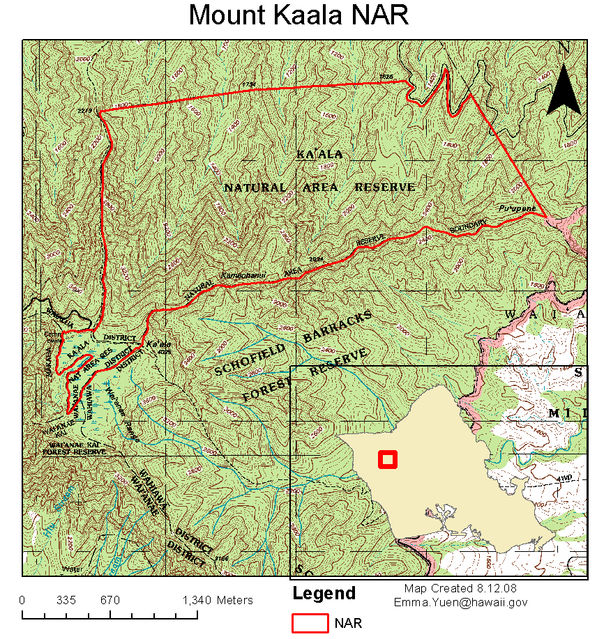Mt. Ka‘ala, the highest peak on the island of O‘ahu, rises to 4,025 feet. Its flat-top profile is a familiar sight to most residents of the island. The product of volcanic eruptions nearly four million years ago, the Wai‘anae Mountains have seen eons of wind and rain, cutting huge valleys and sharp ridges into the extinct volcano. Today, only a small remnant of the mountain’s original flat summit remains, surrounded by wet cliffs and narrow ridges, to which gnarled ‘ohi‘a trees cling. There, often hidden by clouds, an ancient Hawaiian rain forest grows on a fog-bound plateau. As the mists sweeps through the moss-covered branches, a feeling settles over the visitor: This is what Hawai‘i looked like before humans.
Established in 1981, the Mt. Ka‘ala Reserve comprises 1,100 acres of rugged mountain terrain. It protects Hawaiian plants and animals and ecosystems, most found only in Hawai‘i, and some very rare. The only vehicle access is a controlled government road, while arduous ridge trails lead to the summit of Mt. Ka‘ala. There, a boardwalk trail greets the visitor, promising a fascinating walk through a native cloud forest. The boardwalk allows visitors to explore the misty flats of Ka‘ala safely, and with a minimum of impact to the fragile community of Hawaiian plants and animals that have made Mt. Ka‘ala their home for countless generations.
Mt. Ka‘ala is part of the Hawai‘i Natural Reserves System (NARS), which seeks to preserve and protect examples of native Hawaiian ecosystems and their ecological features. Current management projects at the Mt. Ka‘ala Reserve include feral pig and non-native weed control. An ongoing volunteer program has been useful in promoting environment awareness as well as assisting with resource management on the reserve.
Mt. Ka‘ala Reserve is much more than the summit plateau. Most of the reserve’s area consists of steep-sided gulches and ridges that form the eastern flank of Mt. Ka‘ala. In these gulches are lowland forests that once covered the drier portions of O‘ahu, but are now nearly gone. The forests, rich in native species, harbor some of Hawaii’s rarest plants. Only small stands remain, and future management efforts will attempt to expand their range. Reserve managers and volunteers monitor and control the threats to native plants and animals, and help ensure that the rich native resources of Mt. Ka‘ala will endure for future generations.
